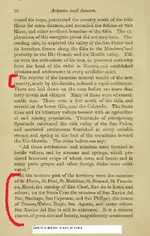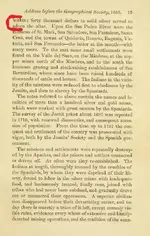Yammy Elf aka SWR wrote
So far, nothing has been presented in this thread that would indicate the Jesuit's were mining, or hide huge treasures.There seems to be a lot of self-interpretation about what was written...and what they might have meant. The "code" myth is a good example. Some are speculating there must be a secret code, because that is how they understand the paragraph to read. Others read it as be careful what you write...the person you are writing about may read the letter.
It appears that you seem to have missed something there.
NOTHING, huh? So when the Jesuits themselves admit that SOME were in fact mining, and a documented case is found, that is "nothing" for you? I understand your skeptical stance toward all "treasure tales" but if the words of Jesuits themselves will not convince you, then one might well conclude you are in fact a biased observer.
To try to bring some relevant passages again to your attention,
That Jesuit missions had rich ornamentation and equipment
"All the churches have side altars, appropriate ornaments, and chalices of silver and in three instances of gold. There are other sacred vessels such as ciboriums, monstrances, large and small candlesticks and crosses, and nearly all churches have silver statues of the Virgin, organs, bassoons, oboes, and bells, not only at the principal missions but at the dependent ones as well.
<
Father Johann Nentvig SJ, Rudo Ensayo>
[Regarding the cathedral in Puebla.] The cathedral church possesses an exceedingly rich treasure in its gold and silver church appointments.In Spain and the Indies the prebendaries and other canons do not have their choir at the high altar. Rather, not far from the church entrance is a large, high partition in front of their seats, and from the choir to the high altar for their sole use runs an aisle enclosed on both sides by railings. These railings run through the entire cathedral church and are of the finest cast silver, each amounting to at least eight hundred weight. The colossally large, silver hanging lamp inspires awe in all visitors. It is more than eight feet across and is very thick and massively decorated. The chains with finger-thick silver links are so heavy that when a ladder is leaned against them they do not move. A man can quite comfortably walk around the edge of the lamp. The decoration is rather ponderous, yet its manufacture by a goldsmith [sic] is supposed to have cost two thousand pesos. I omit mention of the many thick, large silver candlesticks, monstrances, and ciboria of finest gold. Suchlike are found in proportion and abundance in all churches, even those in the smallest villages for the glorious Divine service.
<
Father Joseph Och, SJ, Missionary in Sonora; the travel reports of Joseph Och, S.J., 1755-1767>
That Jesuits would hide the Church treasure in times of emergency
My Reverend Father Gaspar Stiger,<snip>
I came to Terrenate yesterday to hide the ornaments of the church and a family.
Terrenate, November 28, 1751
Your Humble Servant, Keller
If Your Reverence should see the Father Visitor and Juan, give them my affection.
letter from
Ignacio Xavier Keller SJ to Gaspar Stiger SJ, Terrenate, November 28, 1751
(AGI, Guadalajara 419, 3m-49, page 2)
That Jesuit treasures may still exist
If any Jesuit Treasure has survived, it is physically possible that it is a cache of vestments, sacred vessels, and Church ornaments. (But we have yet to to review this possibility in terms of its' concealment and subsequent loss)."
<
Father Charles W. Polzer SJ; in the Aug 1962 edition of Desert Magazine>
That Jesuits were not to be mining
No one will possess knowledge about mining either directly or indirectly; even if his intention is to have a general knowledge about everything, such knowledge would fall under this precept.
<
Father Provincial Francisco de Arteaga SJ (1699-1702)>
Repeated, as apparently the earlier precept was not being obeyed
No one will work mines. This includes the prohibition that no one will have any knowledge about the matter of mining either directly or indirectly. The intention of the precept is to include all forms of knowledge or interpretations that could even fall within the same precept.
<
Father Provincial Andres Javier Garcia SJ(25 June 1747)>
That Jesuits were in fact mining
From archival sources, we know of only two instances in which Padres became involved in mining operations (these being in the Sierra Madre Mission Area). In both cases the men were severely reprimanded and removed.
<
Father Charles W Polzer SJ regarding Jesuit Mining activities from his article in the Aug 1962 edition of Desert Magazine: >
Author Robert Cooper West found
a documented case of Jesuits owning and operating a mine
The Jesuits of Matape mission also engaged in the extraction and refining of silver ores from deposits near Tecoripa, not far from San Miguel Arcangel. According to the rules of the Jesuit order, priests were forbidden to own, operate, or even acquire knowledge of mining. But apparently, ownership of the mines in question had been signed over to the mission by a Spanish miner in payment for debts he incurred for supplies obtained from the padres. Moreover, the priests claimed that the mines belonged to the College of San Jose' at Matape, not to the mission itself, and thus the superiors permitted continuation of the "forbidden" activity.
That Jesuits mining activities were a matter of fact,
As early as 1736 mining was conducted with considerable success by the Jesuit Fathers
<Report on the internal commerce of the United States
By United States. Bureau of Statistics (Treasury dept.), United States. Treasury Dept. Bureau 1890 pp92 >
That Jesuit mines are well known in Argentina and a matter of record
it is well known that they devoted considerable attention to mining we should not therefore go far wrong in assuming that they possessed nearly all the richest mines ie those discovered at that time Two such mines were possessed and worked by the Jesuits somewhere in the mountains of Famatina ...Copies of the old records of those treasure mines of the Jesuits exist...
It is a well established fact that the Jesuits wrote a description of their principal mines indicating their situation and nature and at their expulsion it is believed that these documents were taken to Spain.
Sufficient evidence however exist to prove that the Jesuits mines in the chain of mountains of the Aconquija...
It is stated on good authority by persons of credit who resided in Catamarca that near to the top of the Nevado which is a very high Cerro covered with perpetual snow and situated to the North East of the Fuerte de Andalgala the Jesuits worked a gold mine on the Tucuman side of that mountain and that at their expulsion this mine was shut up by a stone wall....
It is further clear that they not only worked for copper but also worked mines of gold and silver as well and we are obliged to believe that the gold mines they possessed were a source of great riches.
...in certain documents of title of property belonging to the family of Luis Lucero there are indications or records that gold was found in the Cerro Rico of La Carolina by a Portuguese monk Geronimo (Jesuit)
The native Indians did no more than explore on the surface but such works were continued by the Jesuits and after their expulsion by their successors the Aragoneses <Jesuit LAY BROTHERS> who obtained great benefit from this mine which circumstance caused it to be considered the most celebrated of all the other silver mines in this district....
As previously indicated the Jesuits exploited some of the mines existing here and it is highly probable that the veins containing gold were indicated to them by the Indians who were the first exploiters...
Various old workings exist in the mines which according to the best evidence were made by the Jesuits
Evidence exists proving that the Jesuits worked mines in these regions and obtained large quantities of gold from them.
<Official report upon the mines, mining, metallurgy and mining laws, &c., &c ...
By Henry Davis Hoskold, Argentina. 1904>
That these old Jesuit mines have remained un-mentioned and generally un-acknowledged by the Jesuit Order for good reason
it is clear that the Jesuits must have had an intention of returning to the mines on a future occasion.
<ibid>
That Jesuit LAY BROTHERS later returned with enough information to relocate the hidden mines
There is no evidence that mining progressed or even was the object of much attention during the interval which elapsed from the time of the expulsion of the Jesuits to the arrival of the Aragoneses or Lay Jesuits ie Juan Leita and Juan Echavarria The date of their advent in South America is said to be about the year 1777 or ten years after the expulsion but the general opinion is that it was about the year 1803 It is however certain that Juan Leita possessed information derived from one of the expulsed Jesuits and that he in connection with his companion rediscovered several rich mines from which they obtained considerable quantity of gold and silver but if we take into consideration the amount of work which these celebrated spanish adventurers are said to have performed in the Province of La Rioja and that of Catamarca the date of their arrival in South America must have been anterior to 1803 The mines which Juan Leita rediscovered included Santo Domingo Santa Rosa and Viuda in the Cerro Negro Socorro and other in the Tigre San Pedro Bartolome and Mercedes in the Caldera Vieja
A translation of an actual mining claim filed by Jesuit LAY BROTHERS (monks)
The evidence proving that Leita and Echavaria came into the Province of La Rioja and operated in the Famatina mountains is to be found in the original book of Registrations and Demarcations of the mines of San Pedro of Famatina written by the Territorial Judge by order of Don Baltazar Hidalgo de Cisneros Virrey de estas Provincias dated Anguinan 10th June 1810 The record translated is as follows
August 31st 1810 Don Juan Echevarria for himself and in the name of his companion Don Juan Leita natives of the kindgdom of Aragon presented three documents for silver mineral asking for three concessions of mines situated in the Caldera Vieja expressing that two of the said veins of mineral ran in a North and South direction and that the third vein had an East and West bearing naming the mines Bartolome Mercedes and San Pedro de Famatina.
The Jesuit missions HAD TO MAKE A PROFIT. They could not operate indefinitely at a loss, dependent upon the largesse of the Kings of Spain, France or Portugal.
assure you it is delightful to engage in trade over here and to make such handsome profits. If you wish to take a hand in it, let me know your intentions by the bearer, who desires to return and traffic here in pursuance of what he has seen. [6] shall say no more, except to pray God to give you, Sir and Brother, a long life and perfect health. From Port Royal, New France, this 28th of, June, 1610.
Your very affectlonate Brother and servant,
BERTRAND.
<from Première Mission des Jésuites, au Canada, by
Auguste Carayon, S. J. Paris: L'Écureux,1864. FIRST MISSION OF THE JESUITS IN CANADA.* 26>
That the Jesuits had to force the Indians to work is a matter of record, that they used slaves (usually of African origins) is also a matter of record. That the Padres were targeted by the Indians during uprisings is a matter of record. Some of the Indians loved their Jesuit padres, this is also a matter of record. The Jesuits were not more cruel than other missionaries, nor in fact any worse than most European governmental punishments for breaking the laws.
It seems just a bit ridiculous to propose that various Mexican, Argentinian, or any other towns or cities would so loudly boast of their Jesuit mining activities
in order to attract treasure hunters. Firstly there is no need to attribute any of these mines or furnaces to the Jesuits; they could as easily and readily say they belonged to the Spaniards and no treasure hunter would turn up his or her nose at it simply because it were Spanish rather than Jesuit owned originally. For that matter, just how much "tourist dollars" can be attributed to treasure hunters visiting a region? That argument just won't fly.
Next, our older historians often attribute a number of the older mines to the Jesuits;
at that time there was no indication of any kind of stain on the honor of the Jesuits or the Catholic Church, just a matter of history. Today these mines are supposed to be a blot on Jesuit honor, which seems inexplicable. That at least some of these historians got their information on the origins of these mines from Indians (as have several of our treasure writers) is fairly certain, and again there is no reason to denigrate these sources for these same Indians could have just as easily said the mines were Spanish or Mexican and this would not cause any doubt or any treasure hunter to suddenly decide to spend his or her massive tourism dollars elsewhere.
In fact the majority of the old mines and workings were in fact attributed to the Spanish by these same Indians, so do we have any doubts there? This is not good grounds to impeach those Indian sources as witnesses.
One of the examples where Jesuits were accused of having secret gold mines was in the Guarani region, which included much of Paraguay and Uruguay, as well as across the border into Brazil. On their expulsion from Portuguese dominions, none of these alleged gold mines were found, which our Jesuit apologists have pointed to as absolute proof of their "innocence" - however this evidence may yet turn up; for in recent times rich gold deposits have in fact been found in Uruguay, which were missed by early Portuguese explorers due to the fact the gold-bearing strata were hidden by a layer of alluvial deposits which runs from one meter to over 20 meters;
is it so far-fetched to suppose that some Jesuits working at their rich missions and ranches in this very region, while excavating for a well (to give one possible example) or digging a foundation, that the gold could have been discovered? Here is one example of the accidental discovery of gold by the Jesuit fathers,
when the foundations of saint Joseph's Chapel were dug on the shore of lake Huron,—which is nothing but the discharge of lake Superior,—the workmen found a vein, as large as one's arm, of these grains of gold, the sand that was mixed with the vein being so little in quantity as to be almost imperceptible in comparison with the rest. But the workmen, who knew that there were mines of copper in those regions, being persuaded that it was from a brass mine (in ignorance that brass is a composition), filled in the foundations which they had dug, without knowing that they were sealing up a treasure there.
Relation of that occurred in the Mission of the Fathers of the Society of Jesus, in the countries of New France, from the Summer of the year 1659 to the Summer of the year 1660.CHAPTER III.OF THE CONDITION OF THE ALGONQUIN COUNTRY, AND OF SOME NEW DISCOVERIES Sent to Reverend Father Claude Boucher, Provincial of the Province of France.
The Jesuits deceived their own hired workmen concerning the existence of this gold deposit in this instance. Jesuit Father DeSmet also "accidently" found gold in the Black Hills of Dakota, and kept it secret - unsucessfully, mentioning the fact at a dinner party and in a letter written to his brother, but that the Jesuits were quite well educated and were trusted to locate and identify mineral deposits is undisputed. The fact that they had their own mining schools should point up their well-known expertise in the matter. Should we then be surprised that Father Och SJ just "happened" to have a flask of mercury on him, to test gold, unless the good father had a real interest in mines and minerals - beyond the academic treatises.
My apologies for RE-posting so much of what has already been posted, but it seems that a fair amount of information has been ignored or simply missed. I have no bone to pick with Yammy Elf or anyone on this matter - and have strong doubts that I can ever change the minds of some folks, which is no reflection on their intellect or perceptions
but on my failure to locate the evidence they desire to see, and to present the case in strong enough terms to persuade.
As this post is already grown quite long, I will close here.
Merry Christmas & Happy Holidays to you Yammy Elf, and to everyone reading this.

Oroblanco


<Hot cocoa this time!>





 <Hot cocoa this time!>
<Hot cocoa this time!>
 Are you not willing to concede that even in Mexico, there are documented cases of Jesuits mining, owning mines, and concealing treasures?
Are you not willing to concede that even in Mexico, there are documented cases of Jesuits mining, owning mines, and concealing treasures? 




